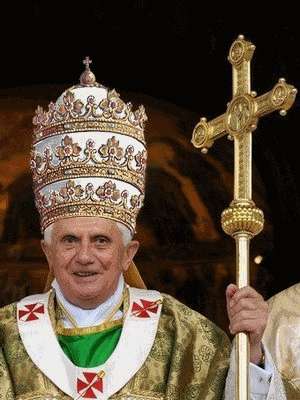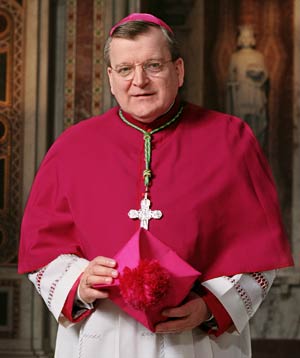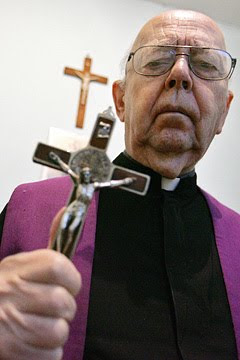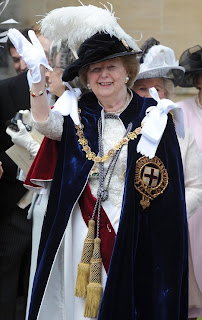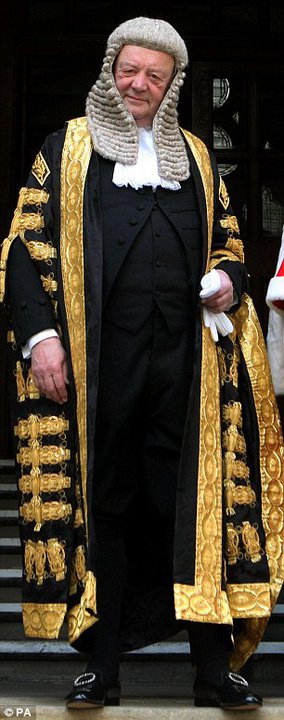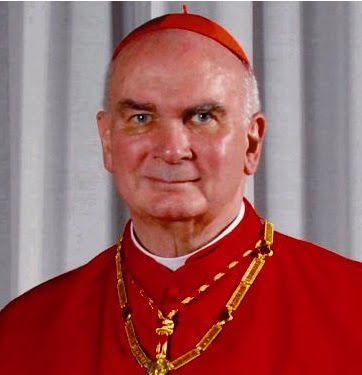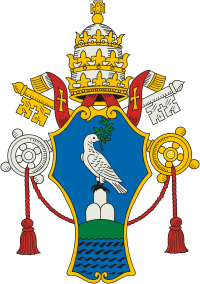The Thocracy of the Restored Papal States World Factbook

The Most Sacred and Glorious Theocracy of the Divinely Restored Papal States.

Under the Seal of His Holiness Pope Celestine VII
Geography
Mainland Area: 1,285,216 km2 (496,225 sq miles) (About the Size of Peru)
Coastline Length: 4,828 km
Highest Point: 6,768 m
Lowest Point: -34 m
Natural Resources: Gold can be found in the Northern mountains while off the north-eastern coast there is a fairly large oil field.
History
The Papal States were restored on the 29th of June 96 Years ago by St. Benedict XXI. At that time The College of Cardinals of the Roman Catholic Church had just met to elect a new Pope following the recent death of Pope John XXVI, two clear candidates arose for the Papacy, Cardinal Levada of Caramella and Cardinal Hume. The conclave lasted two months and led to the victory of Cardinal Levada who chose the name Pope, John XXVII. The matter wasn’t laid to rest though as Cardinal Hume who had narrowly lost the election declared foul play, claiming that Cardinal Levada had bribed cardinals and had tampered with the votes, this led to the events of the 29th of June when a rival conclave of dissatisfied cardinals was formed in the small city of San Martino, this conclave duly elected Cardinal Hume and released a statement declaring the previous conclave invalid and corrupt. Following his election Cardinal Hume took the name of Pope Benedict XXI, as a response to this Pope John and Pope Benedict excommunicated each other. Pope John also excommunicated all those cardinals who took part in the rival conclave. As he knew he could not remain in San Martino Pope Benedict issued a decree restoring the ancient Papal States.
He swiftly moved to the then small Carmel city, and commanded all Bishops of the world to attend him there and recognise his authority.
Six years ago, a great tragedy occurred in the Restored Papal States. On the 17 of April Pope Michael XII was attending the Papal Court. Just after the Pope’s arrival the Dean of the College of Cardinals and a number of other cardinals had just approached the throne to welcome him, when assassins began to fire down from a balcony above the hall. The first fatality was that of the Dean who was shot dead as he rose from his kissing of the ring. The Pope was shot six times in all and was carried away under fire by his bodyguards and several cardinals who attempted to shield the pope from fire. The College of Cardinal Regents taking up authority automatically due to the see being impeded, this power would be lost only by the Grand Council voting to recognise the death of the Pope, when It would transfer to the cardinal Camerlengo. The Pope died two hours later in St. Mary’s Hospital. In total the Dean and seventeen other cardinals were killed in the attack, as well as twelve other members of the court.
Three hours after his death the Pope was carried back to the Grand Basilica by The Noble Guard. There he was laid out in the grand audience chamber where he was attended by the senior members of the Grand Council. In their presence the Cardinal Carmelengo did verify the pope’s death with the silver hammer, and broke the ring and seal.
The next day at an emergency convocation the Cardinal Carmelengo announced the death of the Pope, and called on the council to vote to recognise the death, so the normal processes may begin to elect a new pontiff. The council though failed to reach the required vote to recognise the Pope’s death due to a faction, in the assembly of nobles, which refused to recognise his death as it opposed the supreme rule of the Pope. Thus the legal situation deteriorated into a permanent situation of an impeded See. The situation remains like this awaiting the recognition of the Grand Council.
Government and Political Structure
Long Name: The Most Sacred and Glorious Theocracy of the Divinely Restored Papal States.
Short Name: The Theocracy of the Restored Papal States
Government type: Theocracy. Absolute power is held by the Pope who reigns for life, the new Pope is elected by the College of Cardinals in solemn conclave. There is though an elected House of the People.
Capital city: New Vatican City
Head of State: His Holiness Pope Celestine VII
Secretary of State (Prime Minister): His Eminence, Cardinal Titus.
National Holidays:
29th of June, Foundation day
10th of October, Anniversary of the coronation of St. Benedict XXI
8th of December, The memorial of the death of St. Benedict XXI founder of the nation.
25th December, Christmas day
Shrove Tuesday
From Holy Thursday to the end of the Easter Octave.
Pentecost
The Anniversary of the election of the reigning Pope
The Anniversary of the coronation of the reigning Pope.
Main Constitutional Documents:
The Apostolic Constitution – Outlines the powers of the Pope and the running of the nation.
The Articles of Foundation – The principles and founding laws of the nation.
Major Cities: Carmel City – Largest City in the Nation, Capital of the Archdiocese of St Dominic. Location of the autumn meeting of the Grand Council, the House of the People is also located here.
Florantina – Capital of the Archdiocese of St. Catherine, location of the spring meeting of the Grand Council, The House of Honour is also located here.
Lorenza - Capital of the Archdiocese of St. Pius X
Diakona - Capital of the Archdiocese of St Laurence
Administrative Divisions: the Nation is divided into 5 Physical Archdiocese four of which contain thirty three dioceses. Each Diocese is divided into Deaneries which are divided into parishes; the parish is the smallest division. The fifth archdiocese known as the Archdiocese Major surrounds the capital and is divided into 13 dioceses.
The five Physical Archdioceses in Order of Land size smallest to Largest.
Archdiocese Major of SS. Peter & Paul
Archdiocese of St. Laurence
Archdiocese of St. Pius X
Archdiocese of St. Catherine
Archdiocese of St. Dominic
Executive Branch Structure: The Executive is led by the Pope through his two legates the Dean of the College of Cardinals who oversees The Congregations of the Holy See and the Secretary of State who oversees the Papal Curia of State.
The Administration is divided between two branches The Congregations of the Holy See which oversee the spiritual side of the nation and govern all adherents of Papal Catholicism worldwide, and the Papal curia of State. The Papal Curia of State governs the physical state and its international relations.
The College of Cardinal Regents takes the place of the Pope when he is impeded from carrying out his duties.
Deputy Secretary of State: His Grace, Archbishop Thomas D'Angelo
Foreign Secretary: The Secretary of State (See above)
Head of the Diplomatic Corps: His Grace, Archbishop Stephen La-Rocca
Chancellor of the Exchequer: His Eminence, Cardinal Coleman
Defence Secretary: His Eminence, Cardinal Monroe
Justice Secretary: His Eminence, Cardinal Beckett
Cardinal Carmelengo: His Eminence, Cardinal Moore
Legislative Branch Structure: Legislation is by decree of the Pope, who is free to make any decree he wishes, unless prohibited in The Apostolic Constitution. When the throne is vacant the Cardinal Carmelengo fulfils this role. Due to the current state of affairs with the Pope not recognised as dead, the office of the Papacy is carried out by the Council of Cardinal-Regents.
Legislation may be submitted to the Pope for Papal Assent, thus making a Bill into an Act, only through the Grand Council. Five Bodies make up the Grand Council, which normally meets twice a year for a simple meeting and once a year for a full convocation. The votes are distributed to the five bodies unequally and are;
The House of the People: 15%
The College of Bishops: 15%
The College of Cardinals: 30%
The Assembly of Nobles: 15%
The House of Honour: 25%
For a Common Bill to pass it must gain 50% of the vote including at least 15% support in each body. Matters of substance require 75% of the vote with at least 25% support in each body, matters of substance can only be voted on at Convocation.
The only bodies which may submit bills to the Grand Council are the House of the People, and the House of Honour, though it is the right of the Dean of the College of Cardinals to himself submit bills to Convocation. Each House has its own ways of creating and submitting bills to the council.
The House of the People is made up of 303 Representatives Regular, with two elected from each Diocese except those in the Archdiocese Major who each elect 3 representatives. Each diocese also elects one Super Representative, whose vote is worth the same as three Representatives Regular, except the Archdiocese Major which sends 12 Archdiocesan Super Representatives. This totals 144 Super Representatives, giving a total house size of 447. A term in the House is five years, with an election each year which replaces one Archdiocese’s representatives, with the cycle of elections fixed. To be eligible for House membership the candidate must be an ordained cleric who is at least 30 years old and who has been ordained at least 5 years. Along with the House of Honour, this House submits Bills to the Grand Council.
The three officers of Lesser Triumvirate preside over the House's debates, determining which members may speak. The Triumvirate is also responsible for maintaining order during debate, and may punish members who break the rules of the House. They also call the meetings of the house and have many other powers. The head of the Lesser Triumvirate is the Speaker of the House, The Speaker is a Super Representative who is elected a secret ballot of The House to the post, a term lasts a year and a speaker may not serve more than five consecutive terms. The Protodeacon of the House, is the longest serving member of The House, he is responsible for ensuring the records of meetings are accurate. He is also responsible for ensuring the fairness of the vote. The Lawmaster of the House advises the House on the law and ensures all the actions of the House and its members are legal. The Lawmaster is normally an experienced legal professional, with many years of House membership; the Lawmaster is selected by a special committee, and then ratified by a vote of the House. Upon tking up office the Lawmaster loses his seat in the house and a by-election occours in his diocese. A vote of confidence in the Lawmaster occurs every five years, and is done by secret ballot.
Speaker of the House: Mgr Thomas Botelino SREP
Protodeacon of the House: Mgr Simon Burke REP
The House of Honour is an appointed House, to which any citizen not in a different branch of the Grand Council may be appointed to as a voting member, a non-voting seat may be given to a non-citizen. A person is promoted to the House of Honour for distinguished service to the State or the Pope, and remains in position for life, excluding in the case of excommunication. There are up to 100 Full members, up to 200 Speaking only members and an unlimited number of observer members. Along with the House of the People, this House submits bills to the Grand Council. The House is presided over by the Papal Vicar of Honour, which is the higest honour in the house.
Papal Vicar of Honour: Rt Hon. Elizabeth Aragon.
The College of Bishops is made up of all the validly consecrated, non-censured and recognised bishops of the church, a diocesan archbishop having 5 votes, a non-diocesan archbishop having 4 votes, a diocesan Bishop having two votes and all other bishops having a single vote, except where the Pope has decreed otherwise. The Dean is elected by the College yearly.
Dean of the College: Rt Rev. Paul Clark, Bishop of Morella
The College of Cardinals is made up of all the Cardinals of the Church, though only the 145 most senior cardinals have voting rights.
The Assembly of Nobles, is made up of all those who hold peerages and titles of the third rank or above, all members may speak in the assembly, though only Citizens have voting rights.
Grandmaster of the Assembly: Rt Hon , Lord Hanover, Lord Grand Cross of the Order of St. Peter and Duke of San Genero.
Judicial Structure/Legal System: There are three types of Criminal Court, Courts of State, which conduct trials for civil offences alleged to have been committed by a lay person and non citizens who are not clerics. Tribunals of the Holy See, which try lay people for breaking the rules and laws of the Church. There are also the Ecclesiastical Courts which try clerics for any crime.
Civil Cases are brought before a general tribunal, except when at least one party is a cleric when it goes to an Episcopal Trial presided over by the diocesan bishop or his legitimate representative.
Courts, excluding tribunals of the Holy See, operate at four levels, deanery, diocesan, archdiocesan or universal. Tribunals of the Holy See do not take place at deanery level.
Judges of Deanery level are appointed by the diocesan bishop. Judges/Tribunes of diocesan Level are appointed by the archbishop, archdiocesan judges/tribunes are appointed by the Prefect of the Congregation for Tribunes of the Holy See, for Tribunals of the Holy See, for other courts the Judges are appointed by the Secretary of Justice. Judges/Tribunes of Universal Jurisdiction are appointed directly by the Pope.
The Pope is the final place of appeal and may pardon or condemn any person.
There is no death penalty.
Suffrage: All persons over the age of 21, with the ability to read and write, may vote in the elections for The House of the People, and may lodge a petition to any part of the Grand Council, or directly to the Pope.
Political Parties: Officially organised political parties are illegal though members of the House of the People may identify themselves as liberal, moderate or conservative.
People and Population
Total Population: 250,870,000
Life Expectancy at birth: male: 79.16 years
Female: 84.53 years
Ethnic Groups: White Mediterranean – 62%
Native – 30%
Other White – 4%
Asian – 2%
Hispanic – 1.3%
Black - 0.9%
Arabic – 0.6
Other - 0.1%
Religions: Papal Catholicism – 96%
Roman Catholicism – 1.5%
Other Christian – 0.8%
Atheist – 0.7%
Judaism – 0.5
Paganism - 0.42%
Other – 0.08%
Languages: State Language – Latin
Italian
English
Over 90 Native Languages
Spanish
Greek
Literacy Rate: 99.9%
Communications
Number of Televisions: 30.600.00
Television Stations: 24 channels, including 6 State Sponsored ones.
Web Extension: .PS
Other Information
Papal anthem:http://www.youtube.com/watch?v=CzzvbpoInok
Locations of Major Embassies:
Pysskl Capital of The Democratic Commonwealth of Elyomia - Ambassador - His Grace, Archbishop John Romero
Sarnath capital of The Queendom of Elizabetta - Ambassador - His Grace, Archbishop Rowan Moore
Jakarta Capital of The Republic of Christian Indonesia - Ambassador - His Grace, Archbishop James Monroe
Pendragon Imperial Capital of The Holy Empire of Neue Sansoucci - Ambassador - His Grace, Archbishop Benedict Lombardi
Ar Basel Capital of The Emirate of Tarmeca -Ambassador - His Grace, Archibishop Joseph Gastigard
Locations of Major Consulates:
Other Diplomatic Establishments and personages:
His Eminance, Cardinal Constantus, Papal Legate to the World Assembly
Notable Embassies/Consulates on Papal teratory:
The Holy Empire of Neue Sansoucci - Embassy - Ambassadorial Palace (Willow Suite), New Vatican City - Count Demetrio von Glucksten
The Kingdom of Roumania - Embassy - San Angelis Crescent (Agate House), New Vatican City - Mr. Daniel Tasoi
Treaties and Alliances:
Non-Aggression Treaty with the Democratic Commonwealth of Elyomia
Non-Aggression Treaty with The Holy Empire of Neue Sansoucci
Non-Aggression Treaty with the The Kingdom of Roumania
Notable legislation.


